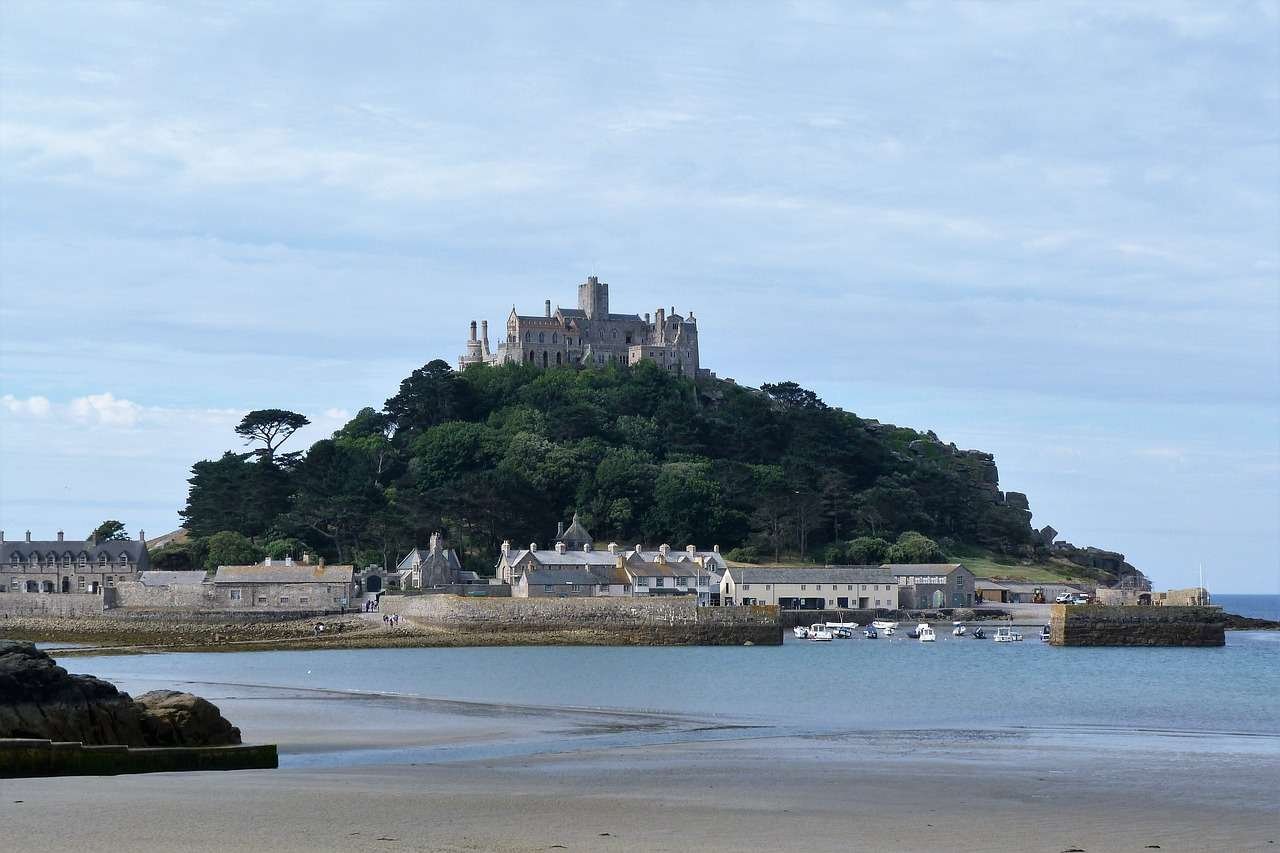There’s something almost mystical about the coastlines of the UK. Here, where the wild Atlantic meets craggy cliffs and ancient sands, lies a world waiting to be discovered. Some beaches are whispers of forgotten histories, while others are serene escapes far from the world’s noise. Imagine stepping onto a secluded shore, where the salty breeze carries tales as old as time, and the horizon stretches out like a promise of adventure. These aren’t just places to sunbathe—they are portals to another realm, one where the land speaks to the soul and the sea beckons with secrets.
Today, we invite you to journey with us through the top 10 beaches in the UK, a curated selection of hidden gems and celebrated sands that will captivate your senses. From the turquoise waters of Cornwall to the untamed beauty of Scotland, let’s explore these shores that offer more than just a view—they offer an experience that leaves an imprint on your heart. You’re not just about to visit a beach; you’re about to embark on a transformative adventure.
1. Porthcurno Beach, Cornwall: Where the Ocean Meets the Sky
Nestled at the tip of Cornwall’s rugged coast, Porthcurno Beach feels like stepping into a dream. The golden sands stretch out in a crescent, cradled between jagged cliffs, while the sea shimmers in shades of turquoise that wouldn’t look out of place in the Mediterranean. But Porthcurno offers more than just beauty—it’s a beach steeped in history. Once a vital communications hub during World War II, the area is home to the Telegraph Museum, where undersea cables once connected the UK to distant lands.
Walking along Porthcurno’s shore, you might imagine the whispers of those cables beneath your feet, carrying messages across oceans, linking continents. The sand here is soft and fine, perfect for sinking toes into while watching the surf roll in. The cliffs shelter you, creating an almost ethereal sense of seclusion. And then there’s the sound—the rhythmic crash of waves, like a lullaby from the deep, harmonizing with the occasional call of seabirds overhead.
If you’re feeling adventurous, the South West Coast Path offers a cliff-top walk with views that are nothing short of breathtaking. Standing on the cliffs, with the wind whipping through your hair and the sun warming your skin, you’ll feel connected to something ancient, something vast.
2. Luskentyre Sands, Isle of Harris: A Canvas of Colour
Luskentyre Sands, on Scotland’s Isle of Harris, feels like it belongs in a painting. Its vast stretch of white sand is met by crystal-clear waters that shift from emerald green to sapphire blue depending on the light. It’s a beach that plays tricks on the senses—on a sunny day, you might mistake it for a tropical paradise, but the towering, snow-capped peaks of Harris remind you that you’re very much in the Hebrides.
Luskentyre’s beauty is wild and untamed. The beach is remote, accessible only by a winding single-track road that weaves through the moorland. As you step onto the sand, the sense of isolation is almost overwhelming. The air here feels different—crisp, pure, as if you’re breathing in the essence of the landscape itself. Time slows down, and the cares of the world seem to fade away with each crashing wave.
But there’s more to Luskentyre than its beauty. It’s a place rich with history and Gaelic culture. The local communities have lived on this land for centuries, and their connection to the sea is palpable. Take a moment to sit and absorb the scene—the mountains standing sentinel in the distance, the ever-changing colours of the sea, the quiet, almost reverent atmosphere. This is a place where the land and sea seem to speak to each other in a language older than time.
3. Rhossili Bay, Wales: Nature’s Grand Theatre
Rhossili Bay is not just a beach; it’s a spectacle. Stretching for three miles along the Gower Peninsula in South Wales, this is a place where nature takes centre stage. The vast expanse of golden sand is framed by dramatic cliffs, while the Atlantic Ocean crashes against the shore in a symphony of sound.
Rhossili has been named one of the best beaches in Europe, and it’s easy to see why. But beyond its obvious beauty lies a deeper connection to the natural world. The beach is part of the Gower Area of Outstanding Natural Beauty, and it’s a haven for wildlife. As you walk along the shore, you might spot seals basking on the rocks, or catch a glimpse of dolphins playing in the surf.
The beach also has its secrets. At low tide, the skeletal remains of the Helvetia, a Norwegian shipwreck from 1887, emerge from the sand—a haunting reminder of the sea’s power. It’s moments like these that make Rhossili Bay more than just a beautiful spot; it’s a place where the past and present collide, where every grain of sand tells a story.
4. Holkham Beach, Norfolk: A Stately Escape
Holkham Beach, part of the sprawling Holkham Estate, is a place of grand, windswept beauty. This vast stretch of sand is bordered by sand dunes, pine forests, and the Holkham Nature Reserve, creating a landscape that feels both wild and serene.
The beach has a regal quality, perhaps because it was once the playground of British royalty. It’s easy to imagine Elizabethan lords and ladies walking along its shore, their footsteps washed away by the tide. Today, it’s a haven for walkers, birdwatchers, and those looking to escape the hustle and bustle of modern life.
Holkham’s beauty lies in its simplicity. There are no noisy amusement arcades or crowded promenades here—just the sound of the wind in the dunes, the cry of seabirds, and the gentle ebb and flow of the tide. As you walk along the beach, the sand underfoot firm and cool, you can feel the vastness of the world around you, and the smallness of your place within it.
5. Barafundle Bay, Pembrokeshire: A Hidden Gem
Tucked away on the Pembrokeshire coast, Barafundle Bay feels like a secret waiting to be discovered. Accessible only by foot, this secluded beach is framed by rugged cliffs and dunes, creating a sense of utter isolation.
As you make the short walk from the car park to the beach, the landscape opens up before you—a wide arc of golden sand, lapped by gentle waves. There are no facilities here, no shops or cafes, just the beach and the sea. It’s a place to disconnect from the world and reconnect with nature.
The beauty of Barafundle lies in its simplicity. The beach feels untouched, as if time has forgotten it. You can spend hours here, exploring the rock pools, building sandcastles, or simply sitting on the shore, watching the waves roll in. And when the sun sets, casting the cliffs in a warm, golden light, you’ll feel as if you’ve stumbled upon a hidden paradise.
6. Durdle Door, Dorset: A Geological Marvel
Durdle Door is perhaps one of the most iconic and recognizable natural landmarks in the UK. Located along Dorset’s Jurassic Coast, a UNESCO World Heritage site, this stunning beach isn’t just a place of relaxation but also a geological masterpiece. The arch of Durdle Door, formed from ancient limestone, stands proudly against the azure waters, a testament to nature’s enduring power to shape and sculpt the landscape over millennia.
As you walk the steep path that descends to the beach, the view is breathtaking—the arch rising from the sea like a gateway to another world, the sun casting long shadows across the shore. The cliffs that surround you are alive with the history of Earth itself, containing fossils that tell stories of life millions of years ago. Every step you take feels like a journey through time.
The beach beneath the arch is a mix of shingle and sand, and the waters are perfect for swimming on a calm day. You can’t help but feel small in the presence of Durdle Door, its grandeur both humbling and awe-inspiring. As the waves lap against the arch, you begin to wonder about the forces that shaped this ancient formation, and how, despite the passage of time, it remains steadfast and unyielding.
For those seeking adventure, there are plenty of nearby coastal walks that offer panoramic views of the Jurassic Coast. The chalk cliffs stand tall against the sky, and on clear days, the sight is one that stays with you long after you’ve left. As the sun sets and Durdle Door is bathed in a warm, golden glow, the sense of timelessness is almost palpable.
7. Bamburgh Beach, Northumberland: Where History Meets the Sea
Bamburgh Beach, located on the wild Northumberland coast, is a place where history and nature collide in the most spectacular way. Overlooking the beach is Bamburgh Castle, a mighty fortress that has stood for over 1,400 years, casting its shadow over the pristine sands below. As you walk along the beach, with the roar of the North Sea in your ears and the sight of the imposing castle in the distance, you can almost feel the weight of history pressing down upon you.
The beach itself is a vast expanse of golden sand, perfect for long walks and exploration. The wind here is bracing, carrying with it the scent of salt and seaweed, and the crashing waves are a constant reminder of the untamed power of the ocean. Despite the beach’s raw, natural beauty, it’s the presence of Bamburgh Castle that truly sets it apart. Standing tall against the sky, the castle seems to watch over the beach like a sentinel from another time, its ancient walls filled with stories of battles and kings.
Bamburgh Beach is also a place for wildlife lovers. The nearby Farne Islands, visible from the shore, are home to puffins, seals, and a wide variety of seabirds. The connection to nature here feels immediate and unspoiled, a reminder of the delicate balance between land and sea. As the sun dips below the horizon and the castle’s silhouette becomes a dark outline against the glowing sky, you’re left with a deep sense of connection to both the past and the natural world.
8. St Ninian’s Isle, Shetland: A Sacred Meeting of Land and Sea
Located in the northernmost reaches of the UK, St Ninian’s Isle in Shetland offers one of the most unique beach experiences you can find. The beach itself is a tombolo—a narrow strip of sand that connects the mainland to the small island of St Ninian’s. Walking along this natural causeway, with the sea on both sides, you feel as if you’re straddling two worlds.
The water here is a stunning, crystalline blue, and on a clear day, it feels as if the sky and sea are one. The sands are soft and white, and the only sounds are the gentle lapping of waves and the distant cries of seabirds. This is a place of solitude, a place to escape the rush of modern life and connect with something older, something sacred.
St Ninian’s Isle is also steeped in history. Archaeological finds on the island suggest it was a site of religious significance, with early Christian relics discovered in the 1950s. Walking the beach, you can almost imagine the monks who once lived here, gazing out over the same stretch of sea, contemplating the mysteries of life. The air is thick with a sense of serenity, of peace, as if time itself slows down in this quiet corner of the world.
This is a beach for reflection, a place to let the wind carry away your worries and the sea cleanse your soul. The tombolo is constantly reshaped by the tides, a reminder of the ever-changing nature of life, but for the time you spend here, it feels like you’re standing on sacred ground, where land, sea, and sky meet in perfect harmony.
9. Three Cliffs Bay, Wales: A Painter’s Paradise
Three Cliffs Bay on the Gower Peninsula is a masterpiece of nature’s artistry. The bay gets its name from the three distinctive limestone cliffs that rise from the shore, creating a dramatic backdrop for one of the most picturesque beaches in the UK. It’s the kind of place that feels like it belongs on the cover of a travel magazine or in the pages of a classic novel—a landscape that evokes both awe and tranquility.
The walk to the beach is an adventure in itself, requiring you to navigate through sand dunes and along a river that winds its way through the valley. As you approach the beach, the cliffs loom large, their jagged peaks a stark contrast to the smooth, sweeping sands. The beach feels remote, wild, and untouched, with a sense of solitude that makes you feel as though you’ve stumbled upon a hidden treasure.
Three Cliffs Bay is a place where the natural elements are constantly at play. The tidal river carves through the sand, creating ever-shifting patterns, while the sea rolls in, its waves crashing against the cliffs in a rhythmic dance. The sound of the wind whipping through the cliffs, combined with the scent of salt and wildflowers, makes for a sensory experience that is both invigorating and soothing.
For those seeking adventure, the surrounding cliffs and dunes offer ample opportunities for exploration. The views from the top are breathtaking, with sweeping vistas of the Gower Peninsula stretching out before you. As the light changes throughout the day, so too does the landscape, with the cliffs casting long shadows in the golden glow of sunset, making Three Cliffs Bay a painter’s dream come true.
10. Camber Sands, East Sussex: A Coastal Playground
Camber Sands, with its vast expanse of golden dunes, feels like a slice of the Sahara transplanted to the English coast. Stretching for miles along the East Sussex shoreline, this beach is a popular destination for families, windsurfers, and those seeking to escape the hustle and bustle of city life. The wide-open space, soft sand, and rolling dunes make it a playground for adventurers of all ages.
But Camber Sands is more than just a pretty beach. It’s a place where the rhythm of the tides shapes the landscape, where the wind carves patterns in the dunes, and where the horizon stretches out endlessly, offering a sense of freedom and possibility. The beach is particularly popular with kite surfers, and on a windy day, the sky is filled with the bright colours of kites dancing in the breeze.
As you walk along the beach, the sand warm beneath your feet, the sound of the waves is ever-present, a constant reminder of the ocean’s power. The dunes are a perfect spot for a quiet moment of reflection, their soft curves offering shelter from the wind. The sea air is crisp and refreshing, filling your lungs with the scent of salt and adventure.
At low tide, the beach seems to stretch on forever, offering endless opportunities for exploration. The light here is particularly special, especially at sunset when the sky turns shades of pink and gold, reflecting off the water in a dazzling display of colour. As the day draws to a close, you’ll find yourself reluctant to leave, the beauty of Camber Sands lingering in your mind long after the sun has dipped below the horizon.
Conclusion: The Call of the UK’s Beaches
Each beach on this list offers something different—a unique blend of natural beauty, history, and sensory experience. From the wild, untamed shores of Scotland to the serene sands of Cornwall, the UK’s beaches are more than just destinations; they are places of transformation. Whether you’re seeking adventure, reflection, or simply a moment of peace, these shores offer a connection to something greater.
As you stand on the edge of the sea, with the wind in your hair and the waves lapping at your feet, you’re reminded of the vastness of the world and your place within it. The beaches of the UK invite you not just to visit, but to experience, to discover, and to connect. So pack your bags, follow the call of the sea, and let these shores become a part of your own journey.
Call to Action: Share Your Beach Stories
Do you have a favourite beach in the UK? Share your experiences in the comments below, and don’t forget to subscribe for more immersive travel stories!











